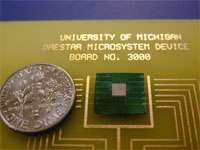New way of making fuel cells using microfabrication lowers costs

University of Michigan researchers are developing ways that could produce fuel cells at a fraction of the current cost by using microfabrication rather than traditional manufacturing processes.
"We arrived at a system that works and uses steps that are very similar to those used to make microelectronic devices," said Levi Thompson, U-M chemical engineering professor and leader of the research team working on the technology.
Image: Using this device design, it is possible, for the first time, to demonstrate a truly integrated micro fuel cell based power supply.
Microfabrication is the creation of physical structures, devices or composite materials whose component parts are sized around 1 micrometer. Microelectronics power a huge range of consumer goods, from greeting cards to hand-held computers.
"One could envisage being able to modify an existing semiconductor or microelectronics fabrication plant to produce fuel cells," Thompson said.
The high cost to build fuel cells is one of the biggest impediments to the commercialization of fuel cells, Thompson said. Lowering production cost is critical to being able to use the technology in real-world applications such as hand-held electronics, and eventually vehicles. Using the technology in cars also depends on lowering the cost.
Traditionally, fuel cells are built similarly to a car, with pieces manufactured separately and then assembled. There is high variability and the process is costly and time consuming. But Thompson’s research group is making proton exchange membrane fuel cells (which are the leading candidate to replace batteries in hand-held electronics and vehicles) using modern electronics microfabrication processes. Instead of assembling the separate parts, the fuels cells are made by "growing" layers upon layers, the same way we currently make microelectronic devices.
Using these lower-cost manufacturing methods, combined with less expensive materials, U-M scientists hope to reduce the cost of fuel cells from nearly $10,000 per kilowatt to less than $1,000 per kilowatt.
"At this lower cost, fuel cells would be competitive with lithium ion batteries, the power supply for many portable electronic devices including cell phones," Thompson said.
"Manufacturers should be able to reduce costs in the same way that costs for microelectronics have been reduced," he said.
"U-M research on using microfabrication to make fuel cells began about two-and-a-half years ago," Thompson said. "The next step is to generate prototypes for third party evaluation. The first market will be for portable electronic devices, but the goal is to someday use fuel cells in automobiles."
Source: University of Michigan

















